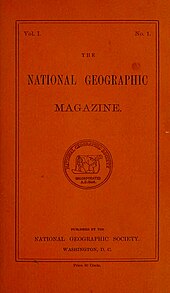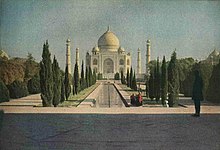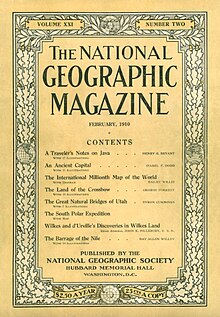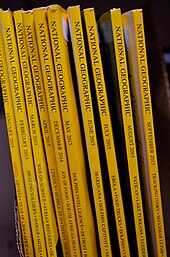
A | B | C | D | E | F | G | H | CH | I | J | K | L | M | N | O | P | Q | R | S | T | U | V | W | X | Y | Z | 0 | 1 | 2 | 3 | 4 | 5 | 6 | 7 | 8 | 9
 | |
 March 2017 cover | |
| Editor | Nathan Lump[1] |
|---|---|
| Categories | Geography, history, nature, science, world culture |
| Frequency | Monthly |
| Total circulation (2022) | 1.8 million (United States)[2] |
| Founded | January 13, 1888 |
| First issue | September 22, 1888 |
| Company | |
| Country | United States |
| Based in | Washington, D.C. |
| Language | English and various other languages |
| Website | nationalgeographic |
| ISSN | 0027-9358 |
| OCLC | 643483454 |
National Geographic (formerly The National Geographic Magazine,[3] sometimes branded as NAT GEO[4]) is an American monthly magazine published by National Geographic Partners.[5] The magazine was founded in 1888 as a scholarly journal, nine months after the establishment of the society, but is now a popular magazine. In 1905, it began including pictures, a style for which it became well-known. Its first color photos appeared in the 1910s. During the Cold War, the magazine committed itself to present a balanced view of the physical and human geography of countries beyond the Iron Curtain. Later, the magazine became outspoken on environmental issues.
Until 2015, the magazine was completely owned and managed by the National Geographic Society. Since 2015, controlling interest has been held by National Geographic Partners.
Topics of features generally concern geography, history, nature, science, and world culture. The magazine is well known for its distinctive appearance: a thick square-bound glossy format with a yellow rectangular border. Map supplements from National Geographic Maps are included with subscriptions, and it is available in a traditional printed edition and an interactive online edition.
As of 1995[update], the magazine was circulated worldwide in nearly forty local-language editions and had a global circulation of at least 6.5 million per month including 3.5 million within the U.S.[6][7], down from about 12 million in the late 1980s. As of 2015[update], the magazine had won 25 National Magazine Awards.[8]
As of April 2024[update], its Instagram page has 283 million followers, the third most of any account not belonging to an individual celebrity.[9] The magazine's combined U.S. and international circulation as of December 31, 2023 was about 1.8 million, with its newsstand "special editions" separately achieving a circulation of about 570,000.[10]
In 2023, National Geographic laid off all staff writers and will stop U.S. newsstand sales in the next year.[11][12][13]
History

The first issue of the National Geographic Magazine was published on September 22, 1888, nine months after the Society was founded. In the first issue, Gardiner Greene Hubbard writes,
The "National Geographic Society" has been organized to "increase and defuse geographic knowledge", and the publication of a Magazine has been determined upon as one means accomplishing these purposes.[14]
It was initially a scholarly journal sent to 165 charter members; in 2010, it reached the hands of 40 million people each month.[15] Starting with its January 1905 publication of several full-page pictures of Tibet in 1900–01, the magazine began to transition from being a text-oriented publication to featuring extensive pictorial content. By 1908 more than half of the magazine's pages were photographs. The June 1985 cover portrait of a 12-year-old Afghan girl Sharbat Gula, shot by photographer Steve McCurry, became one of the magazine's most recognizable images.[16]
National Geographic Kids, the children's version of the magazine, was launched in 1975 under the name National Geographic World.
At its peak in the late 1980s, the magazine had 12 million subscribers in the United States, and millions more outside of the U.S.[2]
In the late 1990s, the magazine began publishing The Complete National Geographic, an electronic collection of every past issue of the magazine. It was then sued over copyright of the magazine as a collective work in Greenberg v. National Geographic and other cases, and temporarily withdrew the compilation. The magazine eventually prevailed in the dispute, and in July 2009 resumed publishing all past issues through December 2008. More recent issues were later added to the collection; the archive and electronic edition of the magazine are available online to the magazine's subscribers.[17]
In September 2015, the National Geographic Society moved the magazine to a new owner, National Geographic Partners, giving 21st Century Fox a 73% controlling interest[18] in exchange for $725 million. In December 2017, a deal was announced for Disney to acquire 21st Century Fox, including the controlling interest in National Geographic Partners.[19] The acquisition was completed in March 2019.[20] NG Media publishing unit was operationally transferred into Disney Publishing Worldwide.[21]
In September 2022, the magazine laid off six of its top editors.[22] In June 2023, the magazine laid off all of its staff writers, shifting to an entirely freelance-based writing model, and announced that beginning in 2024 it would no longer offer newsstand purchases.[2]
Administration
Editors-in-chief
The magazine had a single "editor" from 1888 to 1920. From 1920 to 1967, the chief editorship was held by the president of the National Geographic Society. Since 1967, the magazine has been overseen by its own "editor" and/or "editor-in-chief". The list of editors-in-chief includes three generations of the Grosvenor family between 1903 and 1980.[23]
- Gilbert Hovey Grosvenor (1875–1966): (Editor-in-Chief: February 1903– January 1920; Managing Editor: September 1900 – February 1903; Assistant Editor: May 1899 – September 1900)
- John Oliver La Gorce (1879–1959): (May 1954 – January 1957) (president of the society at the same time)
- Melville Bell Grosvenor (1901–1982): (January 1957 – August 1967) (president of the society at the same time) (thereafter editor-in-chief to 1977)
- Frederick Vosburgh (1905–2005): (August 1967 – October 1970)
- Gilbert Melville Grosvenor (born 1931): (October 1970 – July 1980) (then became president of the society)
- Wilbur E. Garrett: (July 1980 – April 1990)
- William Graves: (April 1990 – December 1994)
- William L. Allen: (January 1995 – January 2005)
- Chris Johns: (January 2005 – April 2014) (first "editor-in-chief" since MBG)
- Susan Goldberg: (April 2014 – April 2022)[1][24][25]
- Nathan Lump: (May 2022 – present)[26]
Articles

During the Cold War, the magazine committed itself to present a balanced view of the physical and human geography of countries beyond the Iron Curtain. The magazine printed articles on Berlin, de-occupied Austria, the Soviet Union, and Communist China that deliberately downplayed politics to focus on culture. In its coverage of the Space Race, National Geographic focused on the scientific achievement while largely avoiding reference to the race's connection to nuclear arms buildup. There were also many articles in the 1930s, 1940s and 1950s about the individual states and their resources, along with supplementary maps of each state. Many of these articles were written by longtime staff such as Frederick Simpich.[27]
After 21st Century Fox acquired controlling interest in the magazine, articles became outspoken on topics such as environmental issues, deforestation, chemical pollution, global warming, and endangered species. Series of articles were included focusing on the history and varied uses of specific products such as a single metal, gem, food crop, or agricultural product, or an archaeological discovery. Occasionally an entire month's issue would be devoted to a single country, past civilization, a natural resource whose future is endangered, or other themes. In recent decades, the National Geographic Society has unveiled other magazines with different focuses. Whereas the magazine featured lengthy expositions in the past, recent issues have shorter articles.[28]
Photography

In addition to being well known for articles about scenery, history, and the most distant corners of the world, the magazine has been recognized for its book-like quality and the high standard of its photography. It was during the tenure of Society President Alexander Graham Bell and editor Gilbert H. Grosvenor (GHG) that the significance of illustration was first emphasized, in spite of criticism from some of the Board of Managers who considered the many illustrations an indicator of an "unscientific" conception of geography. By 1910, photographs had become the magazine's trademark and Grosvenor was constantly on the search for "dynamical pictures" as Graham Bell called them, particularly those that provided a sense of motion in a still image. In 1915, GHG began building the group of staff photographers and providing them with advanced tools including the latest darkroom.[29]
The magazine began to feature some pages of color photography in the early 1930s, when this technology was still in its early development. During the mid-1930s, Luis Marden (1913–2003), a writer and photographer for National Geographic, convinced the magazine to allow its photographers to use the so-called "miniature" 35 mm Leica cameras loaded with Kodachrome film over bulkier cameras with heavy glass plates that required the use of tripods.[29] In 1959, the magazine started publishing small photographs on its covers, later becoming larger photographs. National Geographic photography quickly shifted to digital photography for both its printed magazine and its website. In subsequent years, the cover, while keeping its yellow border, shed its oak leaf trim and bare table of contents, to allow for a full-page photograph taken for one of the month's articles. Issues of National Geographic are often kept by subscribers for years and re-sold at thrift stores as collectibles. The standard for photography has remained high over the subsequent decades and the magazine is still illustrated with some of the highest-quality photojournalism in the world.[30] In 2006, National Geographic began an international photography competition, with over eighteen countries participating.[31]
Gallery
-
Srirangam Temple, India (National Geographic Magazine November 1909)
-
Pyramid of the Niches, El Tajín (National Geographic Magazine February 1913)
-
Spanish Gypsy (National Geographic Magazine March 1917)
-
Kathmandu Market (National Geographic Magazine October 1920)
-
A photo of a glacier taken on an expedition to the North Pole (National Geographic Magazine January 1910)
Map supplements
A map is the greatest of all epic poems. Its lines and colors show the realization of great dreams.
Supplementing the articles, the magazine sometimes provides maps of the regions visited.[33] National Geographic Maps (originally the Cartographic Division) became a division of the National Geographic Society in 1915. The first supplement map, which appeared in the May 1918 issue of the magazine, titled The Western Theatre of War, served as a reference for overseas military personnel and soldiers' families alike.[34] On some occasions, the Society's map archives have been used by the United States government in instances where its own cartographic resources were limited.[35] President Franklin D. Roosevelt's White House map room was filled with National Geographic maps. A National Geographic map of Europe is featured in the displays of the Winston Churchill museum in London showing Churchill's markings at the Yalta Conference where the Allied leaders divided post-war Europe.[36]
In 2001, National Geographic released an eight-CD-ROM set containing all its maps from 1888 to December 2000. Printed versions are also available from the National Geographic website.[37]
Language editions
Active
In April 1995, National Geographic began publishing in Japanese, its first local language edition.[38] The magazine is currently published in 29 local editions around the world.[39][27]


Discontinued
The following local-language editions have been discontinued.[27]






